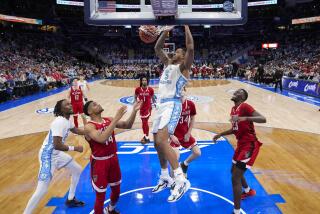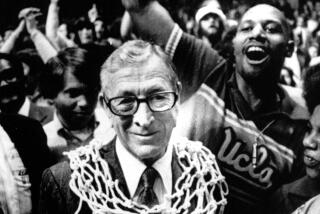Survival of Fittest? All Teams Fit the Mold
DENVER — The way this college basketball season and the NCAA tournament have gone, the Final Four starting here today could be a huge letdown.
“Yeah,” Notre Dame Coach Digger Phelps said, “some team might win by six points.”
With the balance that seems to have developed among most of the nation’s teams, UCLA Coach Jim Harrick said if you rolled back the calendar by two weeks and started this year’s 64-team tournament all over again, “I don’t think there’s any question you would get a completely different outcome, a completely different Final Four.”
Even Arkansas Coach Nolan Richardson, whose team advanced to the Final Four, said this week: “Whether we’re one of the top four teams, I don’t know. I think parity is here and here to stay.”
Parity is why longtime NCAA rules editor Ed Steitz said the game, even with certain warts, “has never been better, has never been more exciting and has never had more charisma. I defy anybody to tell me there has been a better year in college basketball.”
Why?
The inordinate number of close games and upsets are a product of more--and smaller--schools becoming more competitive. There are other reasons: the decreasing influence of low-post-dominating big men playing with their backs to the basket; widespread and creative use of the three-point shot, institution of the 45-second clock, a paucity of players capable of being dominant centers, and an explosion in the number of players capable of dominating from the perimeter.
Or, as Harrick put it: “The coaching is better, the players are better, the equipment is better. Everything keeps getting better. The players are thinking about nutrition and lifting weights at a younger age. The skill level is increasing because they see from the third or fourth grade what can happen to them if they become a basketball player.”
And those third-graders and fourth-graders are looking at a new breed of NBA stars--tall players who excel at everything from running the court to dribbling to passing to outside shooting to 360-degree flying slam dunks.
“Guys like Magic Johnson and Karl Malone,” Harrick said of the Los Angeles Lakers’ 6-foot-9 point guard and the Utah Jazz’s imposing forward. “Those are the kinds of players kids really want to be like. I don’t care if they’re 6-11, they want to be like the Malones and Magics because those are the total, complete players.”
Said Minnesota Coach Clem Haskins: “I think it has become a game of the better athlete, that at 6-6 to 6-9 can play on the perimeter. And I think all of those guys are more face-up type players. You don’t have a low-post player with his back to the basket.
“I think a majority of the young players today--it doesn’t matter whether he’s 5-11 or 7-11--wants to play facing the basket.”
And with the three-point shot being available from 19 feet 9 inches, the court has opened up.
“When they put the three-point shot in it was to take away post play and give more balance to the game,” Phelps said. “Now it seems like there may be an overbalance to the point and the wings. That’s one of the arguments for moving the line” farther away from the basket.
So let’s look at what that means. Georgetown, with 7-2 Dikembe Mutombo learning how to play in the low post and 6-10 Alonzo Mourning learning how to play away from it, loses to Xavier in the second round. Louisville, with 7-foot Felton Spencer, loses to Ball State in the second round. Purdue, with burly center Steve Scheffler setting an NCAA single-season field goal percentage record, loses to Texas in the second round.
UCLA, with 6-10 Don MacLean and 6-9 Trevor Wilson at forward, reaches the final 16. Connecticut, with 6-9 Rod Sellers at center, reaches the final eight. Arkansas, without a player taller than 6-9, reaches the Final Four.
“There are very few Alonzo Mournings, very few Chris Jacksons, but there are a lot of very, very good players,” Xavier Coach Pete Gillen said. “And a lot of those very good players, rather than sitting on the bench at the superpowers, go to a smaller school like a Xavier or a Ball State or a Loyola Marymount. Those teams are not going to win four out of seven, but they can win one out of five. And that’s all you need.”
Gillen had a 6-10 pair in Derek Strong and Tyrone Hill, but they could play facing the basket.
“Everybody in the country wants the great big guys--the Sampsons, the Ewings--but there’s very few of them around,” Gillen said. “Schools have to go with 6-8, 6-9 guys. And those guys have to be flexible. They have to come to the high post and post up low to draw some fouls and get some layups. That’s a trend out of necessity because there are very few great big guys.”
Another trend out of necessity is the increasing number of teams playing up-tempo styles. In the last two tournaments, there have been only two or three teams among the final 16 that could be classified as predominantly half-court teams--Indiana and Duke in 1989, Ball State and maybe Duke this season. In 1988 there were six teams of that type in the final 16. Not that this season’s high-scoring UNLV and Arkansas teams don’t play defense. Those two are among the best defensive teams in the nation. It’s the way they play--up and down the court--what the Razorbacks’ Richardson affectionately calls “40 minutes of hell.”
“For recruiting purposes,” Haskins said, “if you haven’t changed your philosophy, you need to, because a kid’s not going to go where you pass the ball 25 times and not give him a chance to utilize his overall talent.
“I think young people like to express themselves. I think an open-court game where you’re playing pressure defense the kids have a chance to express themselves. That means having the chance to put it behind their back every once in a while or maybe shoot a three-pointer or maybe get out on the break and see what he can do in the open floor.”
Ask freshman guard Kenny Anderson why he chose Georgia Tech and he’ll tell you a “main reason” was that Coach Bobby Cremins has “a lot of confidence in you and lets you play freely. As long as you’re doing everything--going to school and working hard--he lets you play.”
And Cremins is among a breed of go-getters in the ever-crazier world of recruiting. Georgetown’s John Thompson, Indiana’s Bob Knight and North Carolina’s Dean Smith are among the coaches who have earned reputations that enable them to draw quality players without personally engaging in a process Thompson has called the most degrading part of coaching.
But people like Cremins, Providence’s Rick Barnes and Ohio State’s Randy Ayers are out there selling and selling hard.
Earlier and earlier.
“We’ve started recruiting kids in their freshman year in high school,” Ayers said. “You don’t like to say that because I think the kid should be able to concentrate on his academics and his basketball, but you have to do it because everybody else is doing it, and you want to try to compete with everybody else . . .”
Perhaps some of the game is cyclical. Maybe the pure big man will return. But as Purdue Coach Gene Keady said, “The game is changing, and I think times are insisting that we change.”
More to Read
Go beyond the scoreboard
Get the latest on L.A.'s teams in the daily Sports Report newsletter.
You may occasionally receive promotional content from the Los Angeles Times.










